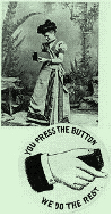WINNING
THE FIRST PRIZE in a photography contest sponsored by the San
Francisco Bulletin in 1909, Dabirma Still was thrilled with her
ten-dollar prize. Her winning entry was a picture of five
horses drinking water from the "Lower Water Hole"
at the La Panza mines on the Still family ranch in southeastern San Luis
Obispo County. She took the picture in 1904.
Dabirma Still was born March 20, 1875,
in San Luis Obispo County. Growing up on the family ranch, Birma was
aware of nature: wild flowers, farm animals and wild creatures, oak
trees, water holes, the heat of summer and the cold of winter. In short,
all that nature could offer plus the people of the small La Panza
community: ranch hands and domestic workers, cowboys and gold miners,
travelers and neighbors all made a very interesting world for Birma.

She chose to capture this world
of hers through the new magical process called photography. At the young
age of 15, Birma decided to become a photographer and set out to earn
her own camera by selling magazine subscriptions. She was successful and
soon was the owner of a box camera.

Two of Birma's cousins --
Fred Adams, a professional photographer in Los Angeles, and Ollie
Sellers, a skilled amateur photographer living in Pozo -- contributed to
and inspired her interest in photography.
In 1890 cameras were quite
primitive. A camera was mounted on a tripod and the photographer covered
the back of the camera and his head with a dark cloth in order to focus
the subject by sighting through frosted or ground glass in the back of
the camera. A leather cap was placed over the camera lens after it was
focused and a plate glass negative (celluloid film is used today) was
inserted in place of the glass plate.
To take the picture, the
photographer removed the leather cap and estimated the time of exposure
by counting 3, 4 or 5 seconds if the subjects were in sunlight and more
if they were in the shade. The cap was replaced over the lens, thus
ending the exposure.
The glass negative was
covered and taken to a darkroom where it was processed with a developing
chemical. Next, the image was fixed or set permanently on the glass
plate in another chemical and then rinsed in water.
A picture of the glass
plate image was obtained by putting a sheet of silver-coated printing
paper in a wooden frame with the glass negative and exposing it to
sunlight. The printing paper then had to be developed and fixed for
permanence in a somewhat similar process to developing the glass plate
negative.

Most of the earlier
photographs taken by Birma were made with her old box camera and the
prints made on "printing out" paper. In the earlier years,
Birma had to silver coat her own printing paper. Later, commercial
printing paper could be bought.
In 1903 a neighbor, Mr.
Upham, purchased a new Kodak camera which used celluloid film rolls
instead of the plate glass negatives. He let Birma use his camera and
showed her how to develop the exposed film rolls and use the new
"indoor printing paper."
CONTINUE
TO PAGE 2

![]()

![]()